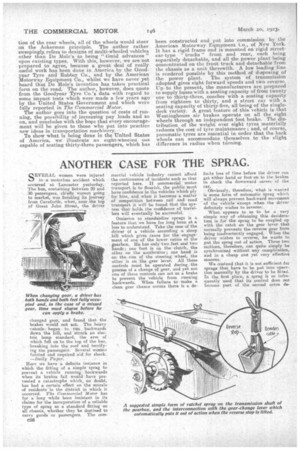ANOTHER CASE FOR THE SPRAG.
Page 28

Page 29

If you've noticed an error in this article please click here to report it so we can fix it.
SEVERAL women were injured in a motorbus accident which occurred at Lancaster yesterday. The bus, containing between 20 and 30 passengers, chiefly Women going to market, was finishing its journey from Carnforth, when, near the top of Great John Street, the driver changed gear, and found that, the brakes would not act. The heavy vehicle began to run. backwards dawn the hill, and struck an electric lamp standard, the arm of which fell on to the top of the bus, breaking into the roof and terrifying the passengers. Several women fainted and required aid for shock. —Daily Paper.
Here we have a definite instance in which the fitting of a simple sprag to prevent a vehicle running backwards when its brakes fail would have prevented a ,catastrophe which, no doubt, has had a certain effect on the morale of residents in the district in which it, occurred. The Commercial Motor has for a long while been insistent in its claims for the incorporation of a reliable type of sprag as a standard fitting on all chassis, whether they be destined to carry goods or passengers. The cam 036 mercial vehicle industry cannot afford the continuance of incidents such as that reported here. If commercial *motor transport is to flourish, the public must have confidence in the vehicles which ply for hire, and when it becomes a matter of competition between rail and road transport it will be found that the system that holds the confidence of travellers will eventually be successful.
Omission to standardize sprags is a feature that we have for long been at a loss to understand. Take the case of the driver of a vehicle ascending a steep _hill which gives cause for the engagement of one of the lower ratios of the gearbox. He has only•two.feet and two hands one foot is on the clutch, the other on the accelerator; one hand is on the rim of the steering wheel, the other is on the gear lever. All these controls must be operated during, the process of a change of gear, and yet not one of these controls can Act as a brake to prevent the , vehicle from running backwards. When failure to make a clean gear chance occurs there is a de
finite loss of time before the driver can get either hand or foot•on to the brakes to check the downward career of the car.
Obviously, therefore, what is wanted is some form of automatic sprag which will always prevent backward movement of the vehicle except when the driver definitely wishes to reverse: What appears to us to be a very simple way of obtaining this desideratum is for the sprag to be coupled op with the catch on the gear lever that normally prevents the reverse gear from being inadvertently engaged. When the driver wishes to reverse, he wants to put the sprag out of action. These two motions, therefore, can quite simply be synchronized without any complication, and in a cheap ann yet very effective manner.
We contend that it is not sufficient for sprags that have to be put into operation manually by the driver to he fitted. In the first place, a sprag is so infrequently used that its control does not become part of the second sense de
veloped by the driver; and, ,what is more, when he has both hands and both feet employed in changing gear he cannot put a sprag into action sufficiently quickly to enable it to ateest the vehicle at the commencement of its backward career when he misses gear and becomes mentally disturbed. Therefore, we urge that the type of eprag that, should universally be adopted is one that is always ready to prevent the vehicle running backwards; that is, it should be put out of action at the wish of the driver when he engages reverse gear, but should not merely be always out of action and only made effective when it is deemed to be desirable. The psychological aspect must be con sidereci, and such is human nature that few of even the -best drivers will admit that they are sufficiently likely to make a blunder in their gear-changing to necessitate dropping the sprags with which theirvehicles are fitted when ascending gradients which are quite steep enough to cause trouble in the case of a missed gear.




















































